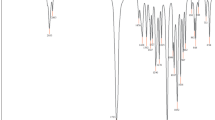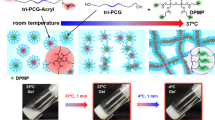Abstract
Poly (ethylene glycol) (PEG) — poly(ε-caprolactone(CL)-co-D,L-lactide (LA)) (PCLA-PEG-PCLA) was synthesized by ring-opening polymerization to form a temperature sensitive hydrogel triblock copolymer. Poly(β-amino ester) (PAE) obtained from 1,4-butanediol diacrylate (BDA), and 4,4′-trimethylene dipiperidine (TMDP) was used as a pH sensitive moiety to conjugate to the triblock copolymer. The physicochemical properties of the temperature-sensitive triblock and pH/temperature-sensitive pentablock copolymers (PAE-PCLA-PEG-PCLA-PAE) were characterized by 1H NMR spectroscopy and gel permeation spectroscopy. The sol-gel phase transition behavior of the PAE-PCLA-PEG-PCLA-PAE block copolymers was investigated. An aqueous solution of the copolymers (20 wt%) changed from a sol phase at pH 6.4 and 10°C to a gel phase at pH 7.4 and 37°C. In addition, the degradation of PAE-PCLA-PEG-PCLA-PAE was compared with that of poly(ethylene glycol) — poly(ε-caprolactone) — poly (β-amino ester) (PAE-PCL-PEG-PCL-PAE) using both in vitro and in vivo experiments. The relationship between the insulin release profile from the matrix and the degradation of these materials also investigated.
Similar content being viewed by others
References
American Diabetes Association, National Diabetes Fact Sheet. www.diabetes.org, 2004 (October 5).
P. Tyagi, Indian J. Pharmacol., 34, 379 (2002).
J. Wang, Y. Tabata, and K. Morimoto, J. Control. Release, 113, 31 (2006).
M. Morishita, T. Goto, N. A. Peppas, J. I. Joseph, M. C. Torjman, C. Munsick, K. Nakamura, K. Takayama, and A. M. Lowman, J. Control. Release, 97, 115 (2004).
G. C. Y. Chiou, U.S. Patent 5283236 (1992).
M. Tobio, R. Gref, A. Sanchez, R. Langer, and M. Alonso, J. Pharm. Res., 15, 270 (1998).
C. E. Soma, C. Dubernet, G. Barratt, F. Nemati, M. Appel, S. Benita, and P. Couvreur, Pharm. Res., 16, 1710 (1999).
S. Cammas, K. Suzuki, C. Sone, Y. Sakurai, K. Kataoka, and T. Okano, J. Control. Release, 48, 157 (1997).
K. Kataoka, G. S. Kwon, M. Yokoyama, T. Okano, and Y. Sakurai, J. Control. Release, 24, 1190 (1993).
M. Qiao, D. Chen, X. Ma, and Y. Liu, Int. J. Pharm., 294, 103 (2005).
A. S. Hoffman, Adv. Drug Deliv. Rev., 3, 53 (2002).
D. Cohn, S. Stern, M. F. González, and J. Epstein, J. Biomed. Mater. Res., 59, 273 (2002).
S. P. Zhao, L. M. Zhang, and D. Ma, J. Phys. Chem. B, 110, 12225 (2006).
X. Huang and T. L. Lowe, Biomacromolecules, 6, 2131 (2005).
Y. W. Yang, Z. Yang, Z. K. Zhou, D. Attwood, and C. Booth, Macromolecules, 29, 670 (1996).
A. Akinc, D. G. Anderson, D. M. Lynn, and R. Langer, Bioconjugate Chem., 14, 979 (2003).
S. R. Little, D. M. Lynn, and R. Langer, Proc. National Acad. Sci. USA, 101, 9534 (2004).
D. Berry, D. M. Lynn, R. Sasisekharan, and R. Langer, Chem. Biology, 11, 487 (2004).
M. S. Kim, D. S. Lee, E. K. Choi, H. J. Park, and J. S. Kim, Macromol. Res., 13, 147 (2005).
D. P. Huynh, M. K. Nguyen, B. S. Pi, M. S. Kim, S. Y. Chae, K. C. Lee, B. S. Kim, S. W. Lee, and D. S. Lee, Biomaterials, 29, 2527 (2008).
D. P. Huynh, M. K. Nguyen, B. S. Kim, and D. S. Lee, Polymer, 50, 2565 (2009).
D. P. Huynh, G. J. Im, S. Y. Chae, K. C. Lee, and D. S. Lee, J. Control. Release, 137, 20 (2009).
M. G. Stevens and S. Olsen, J. Immunol. Methods, 157, 225 (1993).
W. S. Shim, J. S. Yoo, Y. H. Bae, and D. S. Lee, Biomacromolecules, 6, 2930 (2005).
D. P. Huynh, W. S. Shim, J. H. Kim, and D. S. Lee. Polymer, 47, 7918 (2006).
Author information
Authors and Affiliations
Corresponding author
Rights and permissions
About this article
Cite this article
Huynh, D.P., Nguyen, M.K. & Lee, D.S. Controlling the degradation of pH/temperature-sensitive injectable hydrogels based on poly(β-amino ester). Macromol. Res. 18, 192–199 (2010). https://doi.org/10.1007/s13233-009-0182-0
Received:
Revised:
Accepted:
Published:
Issue Date:
DOI: https://doi.org/10.1007/s13233-009-0182-0




